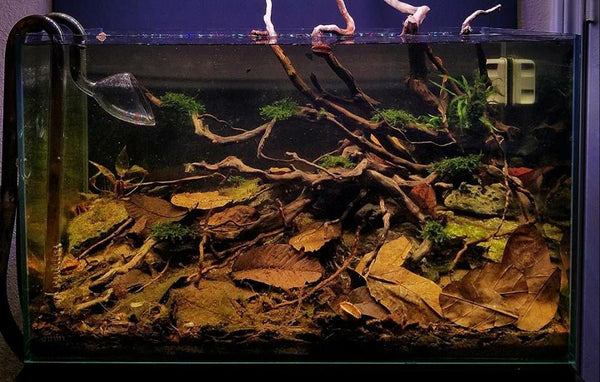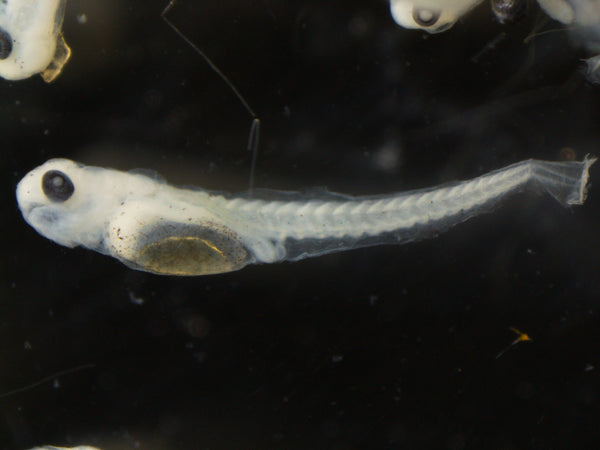- Continue Shopping
- Your Cart is Empty
Getting to the bottom of...the bottom. "Substrate Enrichment", Part 157...
Yeah, I know, we're back to the bottom once again, aren't we?
It's something that I keep coming back to, because the idea of utilizing botanicals in your aquarium substrate keeps tantalizing me with its performance and potential benefits.

As I've obsessively reported to you, I recently set up a small tank in my office for the sole purpose of doing damn near the entire substrate with leaves and twigs- sort of like in nature. There is less than approximately 0.25"/0.635cm of sand in there. I went from throwing in wood to make it look "cool", to ultimately yanking out everything but the leaves and twigs on the bottom. That's the whole "scape." What we in the reef world call a "no scape."
Leaves and a shoal of Parachierdon simulans.
Nothing else.

And the interesting thing about this tank is that it is one of the most chemically stable, low-maintenance tanks I've ever worked with. It's held a TDS of 12 and a pH of 6.2 pretty much from day one of it's operation. It cycled in about 5-6 days. Ammonia was barely detectible. Nitrite peaked at about 0.25mg/L in approximately 3 days.
Now, the point of this piece is not to drop a big old "humble brag" about some new tank I started. The point is to show what I think is an interesting "thing" I've noticed about this tank. Stability and ease of function.
I was quite astounded how a new tank could go from dry to "broken in" in a week or so. And not just "broken in" (ie; "cycled")- like, stable. I don't usually do this, but I tested all basic parameters every day for the first 3 weeks of the tank's existence, just to kind of see what would happen.
The interesting thing about a tank like this is that it relies on leaves in a way that I have rarely done before. Yet, I had complete confidence that it could work just fine. I'm not some "visionary" here- I'm just a guy who's played with blackwater/botanical-style aquariums for a long time and has developed a certain degree of comfort with them. Many of you are in the same position.
What goes on in an aquarium with botanicals- or leaves, in this instance as the total "substrate" or "hardscape", as the case may be, is that they become the basis for biological activity in the tank. As we have discussed a million times here, as botanicals break down, they recruit bacteria, fungi, and other organisms on their surfaces.

What I am starting to feel more and more confident about is postulating that denitrification occurs in a system with a layer of leaves and botanicals as a major component of the tank.
Now, I know, I have little rigorous scientific information to back up my theory, other than anecdotal observations and even some assumptions. However, there is always an example to look at- nature.
Of course, nature and aquariums differ, one being a closed system and the other being "open." However, they both are beholden to the same laws, aren't they? And I believe that the function of the captive leaf litter bed and the wild litter beds are remarkably similar to a great extent.

The thing that fascinates me is that, in nature, leaf litter beds perform a similar function; that is, fostering biodiversity, nutrient export, and yes- denitrification. Let's take a little look at a some information I gleaned from the study of a natural leaf litter bed for some insights.
In a slow-flowing wild Amazonian stream with a very deep leaf litter bed, observations were made which are of some interest to us. First off, oxygen saturation was 6.7 3 mg/L (about 85% of saturation), conductivity was 13.8 microsemions, and pH was 3.5.
Some of these parameters (specifically pH) are likely difficult to obtain and maintain in the aquarium, but the interesting thing is that these parameters were stable throughout a months-long investigation.
Oxygen saturation was surpassingly low, given the fact that there was some water movement and turbulence when the study was conducted. The researchers postulated that the reduction in oxygen saturation presumably reflects respiratory consumption by the organisms residing in the litter, as well as low photosynthetic generation (which makes sense, because there is no real algae or plant growth in the litter beds). And of course, such numbers are consistent with the presence of a lot of life in the litter beds.

Microscopic investigation confirmed this- it revealed that the leaf litter was heavily populated with fungi and other microfauna. There was a significant amount of fish life. Interestingly, the fish population was largely found in the top 12"/30cm of the litter bed, which was estimated to be about 18"/45cm deep. The food web in this type of habitat is comprised largely of fungal and bacterial growth which occurs in the decomposing leaf litter.
Okay, I"m throwing a lot of information here, and doing what I hope is a slightly better-than-mediocre attempt at tying it all together. The principal assertions I'm making are that, in the wild, the leaf litter bed is a very productive place, and has a significant impact on its surroundings, and that it's increasingly obvious to me that many of the same functions occur in an aquarium utilizing leaf litter and botanicals.

Enriching a substrate, or composing an entire substrate of botanicals and leaves is a very interesting and compelling subject for investigation by hobbyists.
So, three areas of potential investigation for us:
*Use of botanicals and leaves to comprise a "bed" for bacterial growth and denitrification.
*Understanding the chemical/physical impact of the botanical "bed" on an aquarium. (ie, pH, conductivity, etc.)
*Utilization of a botanical bed to create a supplemental food source for the resident fishes.
We've also touched on the idea of a leaf litter/botanical bed as "nursery" for fry, something I recently discovered in a conversation with noted breeder Rachel O'Leary that she has embraced for years with much success! This, of course, freaked me out in a very good way!

So, yes, beyond the simple aesthetics, enriching or composing a substrate entirely with botanicals and leaves gives the hobbyist the prospect of success on a variety of fronts!
More to explore...To be continued.
Stay curious. Stay skeptical. Stay diligent. Stay observant...
And Stay Wet.
Scott Fellman
Tannin Aquatics







Scott Fellman
Author